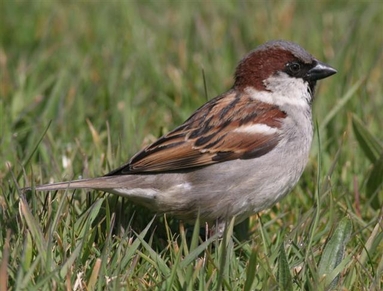The Ups and Downs of Garden Birds

On Arran a large number of people are interested in the birds that come into their garden. They get pleasure from their feathered friends and express concern when numbers go down or species disappear for no apparent reason.
Nationally, data on garden birds has been systematically collected by the British Trust for Ornithology (BTO) for over forty years. The Garden Bird Feeding Survey (GBFS) started in 1970/71 to examine the increasingly popular activity of providing food for birds in gardens and is the longest-running study of its kind in the world. Observations are made on a weekly basis from October to March, with the recording of the maximum number of each species seen using food or water provided. The GBFS encompasses approximately 250 gardens in each year that are selected carefully from the larger year-round BTO Garden BirdWatch (GBW) survey to ensure good geographical coverage across the UK.
Recently, the BTO produced a brief report called “Forty years of the Garden Bird Feeding Survey”. It is available from their website and clearly shows the ups and downs of garden birds. This is a selection from that report.
On the up side, an enormous expansion in the number of people feeding birds and in the types of foods available has lead to more species being supported and, in some, large increases in number. In particular, Goldfinches have shown a 25-fold increase over the past 20 winters, attracted by oil-rich food such as nyjer seed and sunflower hearts. Long-tailed Tits have shown a tenfold increase in GBFS gardens over twice as many winters. Great Spotted Woodpeckers have also become a regular sight for many an armchair birdwatcher, with four times as many flashing into gardens last winter compared with the first winter of the GBFS in 1970/71.
On the down side, the Blue Tit is a surprise addition to the list of declining garden visitors, with a 42% reduction in winter numbers over the last forty years. Other downs include Greenfinch. The GBFS data show that numbers taking food and water in gardens has halved in the past six winters after recent and well-publicised outbreaks of the disease trichomonosis. The national GBFS data reveal a 75% decline in Song Thrush, and a 70% decline in House Sparrow.
I do not think that the national declines in Song Thrush and House Sparrow would be reflected on Arran. I think, but I do not know, because at present there is not enough data recorded on Arran. Thus the appeal to the people on Arran who enjoy their garden birds to think about joining the BTO’s Garden BirdWatch.
Some 16,500 participants in the UK currently take part in the BTO’s Garden BirdWatch. At present there are only 10 participants in Arran, a small proportion of the people on Arran who enjoy their garden birds.
Garden BirdWatch is all about getting involved and gathering useful information using simple recording techniques. The forms are easy to complete and all you need to do is keep a simple note of the birds seen during the course of the week. You can note the birds you see over your morning cup of coffee or while working in the garden. How much time you spend recording is up to you. All that is asked is that you try to be consistent from one week to the next. The observations that are received are added to the national Garden BirdWatch database, building up a pattern, showing how bird species change their use of gardens throughout the year and from one year to the next.
To join Garden BirdWatch go on line to http://www.bto.org/gbw/join_gbw/index.htm or phone 01842 750050
All participants send in simple weekly records of the bird species using their gardens. This information is either submitted on paper count forms or by using Garden BirdWatch Online. Each participant also supports the project financially through an annual contribution of £15. In return, they receive the quarterly colour magazine Bird Table, count forms and access to advice on feeding and attracting garden birds. All new joiners will receive a free copy of “Garden Birds and Wildlife” or “Gardening for Birdwatchers” or “Garden BirdWatch Book”.